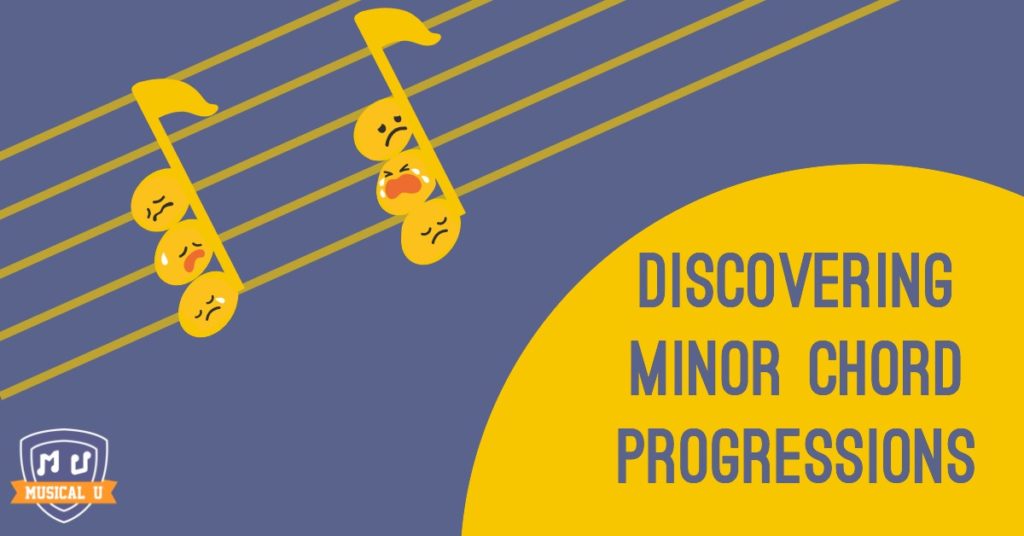Many of us are familiar with popular major chord progressions like I–IV–V–I. Now it’s time to delve into the exciting world of minor chords with the lessons below. A minor scale gives flavor and emotion to a song, adding a level of musical depth that can make a mediocre song moving and distinct from others.
Because so many of our favorite songs are in major keys, those that are in minor keys can stand out, and some musical styles like rock or jazz thrive on complex minor scales and harmonic wizardry.
Minor scales and minor chord progressions generally contain richer harmonic possibilities than the typical major keys and major chord progressions. Minor key songs frequently modulate to major and back to minor. Sometimes the same chord can appear as major and minor in the very same song!
But this heady harmonic mix is nothing to be afraid of.
By the end of this article, you’ll not only understand how minor chords are made, but you’ll know some common minor chord progressions, how they’re derived from a minor scale, how to write these progressions, how they can be used in your own music, and how to come up with your own. With enough listening practice and lessons, you’ll be able to recognize minor chord progressions in songs almost instantly – this will come with time!
Table of Contents:
4. The Top 3 Chords in Minor Progressions
6. Writing Your Own Minor Chord Progressions
A Tale of Two Tonalities
Let’s start off with a bit of basic but important music theory. Western music is dominated by two tonalities: major and minor. While music written in major keys sounds bright and cheery, minor keys tends to be darker and sadder, with chords to match.
Though it may be tempting for the beginner musician to stick to major keys only, the world of minor keys isn’t as sad as it seems – quite the contrary! Minor chords add a depth and richness to your music that major chords alone would not give you. It’s important to remember that everlasting, perpetual happiness in music gets boring. And no, learning minor keys and chords isn’t just for songwriters – they’re also a must for anyone who wants to improve their ear, cover others’ songs, and understand music theory.
Before we dive into the music theory of how we build these melancholy minor chords, let’s compare major vs. minor chord progressions. Just take a listen to this famous R.E.M. tune “Losing My Religion” transposed to a major key. Characteristic of major chords, the song sounds unusually chipper and almost happy, regardless of the lyrics and meaning behind the song. Notice how the change from minor chords to major chords nearly changes the overall style to something that might fit better on a country radio station.
R.E.M. seems pretty chipper in this version of “Losing My Religion” in a major key:
Now compare to the original song, and you can hear how the minor chord progressions add a distinctly morose moodiness that is not evident in the major version. The original R.E.M. tune’s use of minor chord progressions for guitar gives it a particularly brooding quality, as you can see:
What about the reverse?
Sure enough, transposing a song from a major key to a minor key lends a more brooding, melancholy feel to the song. Check out Chase Holfelder’s minor key rendition of “How Far I’ll Go” from Disney’s Moana:
Exercise: Major or Minor?
When learning how to play minor chord progressions, it’s important to hear the difference between different chord qualities. While there are many chord qualities, including diminished and augmented, right now we are going to focus on the difference between a minor and major chord. Remember – the difference between the two is that the minor chord has that flat third (minor third) compared to the major.
In the following six examples you are going to hear a chord. Is it major or minor? Can you grab an instrument and work out exactly which chord it is? Write down your answers and then check with the answers below.
Show answers
- Example 1: C Major
- Example 2: F Major
- Example 3: G Minor
- Example 4: E Minor
- Example 5: B Minor
- Example 6: E Major
How did you do? Were you able to tell which ones were major or minor? Bonus points if you could identify which chord you heard. If you answered all of the answers correctly, you can tell major chords from minor chords and you are ready to move on to chord progressions.
Need a Little More Practice?
What if you need a little more practice? That’s okay! It just takes some time and good practice to learn a new skill like hearing chord qualities.
Here are more great posts, exercises, and information on chords:
- Chord Ear Training 101
- Chord Ear Training Exercises
- Chord Ear Training: How To
- Tone Savvy: Chord Ear Training
- Hearing Chord Progressions: Minor Keys
These posts delve deeper into the mechanics of minor chords and keys, and provide more background information that will prove useful in your minor key journey.
Chords in Minor Scales
Before you can play with chord progressions, let’s talk about the different chords available in minor. Since there are three distinct minor scales – the natural minor scale, the harmonic minor scale, and the melodic minor scale – some of these chords are altered based on which scale you choose, as we’re about to see.
While we are going to discuss these different minor scale variations here a little bit, it’s best not to get caught up in them: in the real world, minor melodies, and the chords supporting them, can vary between the different minor scales in the same piece of music.
Because of the way that we traditionally write a chord progression, where specific tones move towards the tonic or dominant for resolution, the chords that come up in the melodic minor scale or harmonic minor scale are often used rather than the natural minor scale. Without the G# leading tone, the natural minor scale can be ambiguous and lack movement, and can kill a tune by stripping it of musical motion.
Just like with major chords, roman numerals are used to denote minor chords. The upper case roman numerals indicate that the chord is major, while the lowercase roman numerals indicate that the chord is minor, or diminished (indicated by a “dim” following the roman numerals), or augmented (indicated by a “+” following the roman numerals).

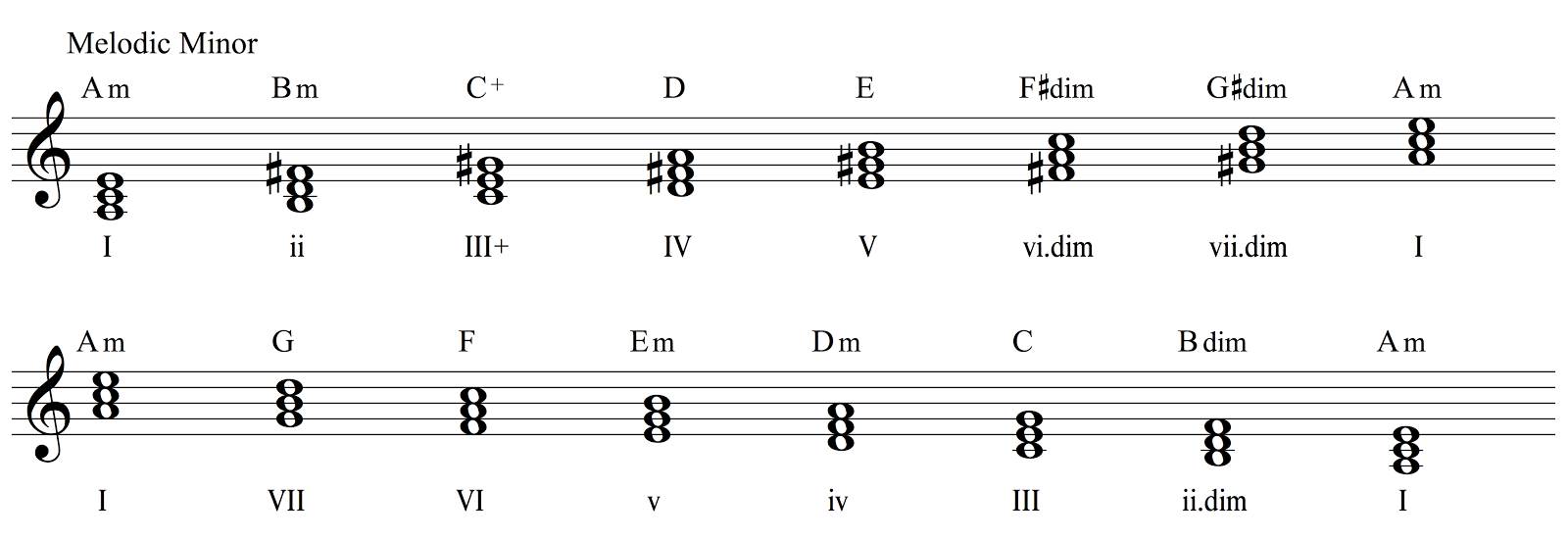
This doesn’t mean that the natural minor scale is never used – depending on your musical style, you may run into it a lot and discover a multitude of uses for it. But for most commercial purposes, you would avoid building a chord progression using the natural minor scale.
Building Minor Chords On Each Scale Degree
To build a basic chord, remember you need to build up triads in the key. In A Major, the I major chord is A–C#–E, but in A Minor, the I minor chord is A–C–E. You have the tonic, the minor third, and the fifth. With minor keys, you can build up this minor chord on the starting note, or the tonic, of any minor scale. On guitar, you have multiple ways of building up any given minor chord, and you even have the option of adding more notes within the chord (for example, adding a high A on top of an existing A minor chord!).
Since the A Minor scale, the relative minor of C Major, has a simple key signature without a single sharp or flat, the below example uses this key. You can apply what you learn with A Minor to other minor keys.
Let’s look at the chords in the A harmonic minor scale, starting on each scale degree. Again, remember that uppercase roman numerals indicate major chords, lowercase roman numerals indicate minor chords, a “dim” after lowercase roman numerals indicates a diminished chord, and a “+” after uppercase roman numerals indicates an augmented chord:

Listen to the A minor chords several times. Notice the quality of the different chords available in the minor scale by looking at the numerals. Since different chords in the scale have different tonal personalities, they will suit different purposes.
Since the leading tone (or G#, represented by vii.dim in numerals) wants to move to the tonic A, you may even find the diminished chord built on the seventh degree of the harmonic minor scale.
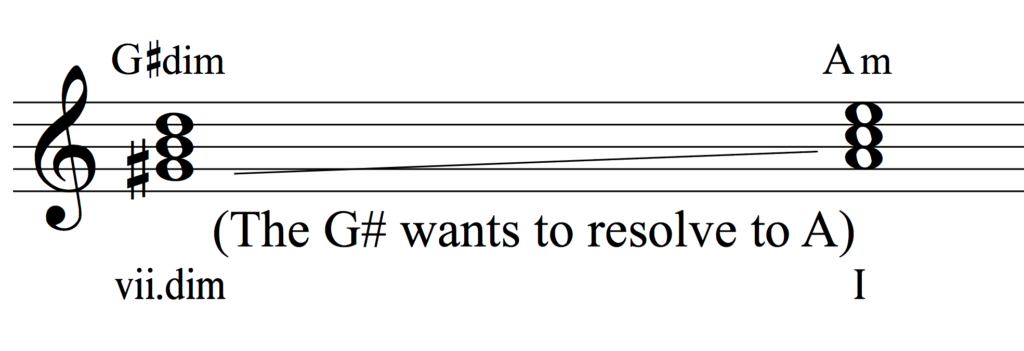 Just like the popular major chord progressions, the minor scale chord progressions want to resolve and move to the tonic or the dominant of the key. What is different is the quality of the chords.
Just like the popular major chord progressions, the minor scale chord progressions want to resolve and move to the tonic or the dominant of the key. What is different is the quality of the chords.
When spelling out the minor chords, keep the key in mind. Listen for resolutions and progressions that bring movement to your song.
The Top 3 Chords in Minor Progressions
You will find out quickly that many of the favorite major chord progressions are mirrored by popular minor chord progressions. Just like progressions in major scales, those in minor scales focus primarily on moving between three chords: the 1, 4 and 5, represented by numerals as I, IV, and V.
As we learned in the first part of this tutorial on Minor Scale Basics, the 5 (a.k.a. “dominant”, a.k.a. V in numerals) chord in a minor key can be the major version (V) or minor (v).
Listen to the audio example below. In the first audio sample, the progression includes the minor 5 chord, or an E minor chord (v). Feel free to follow along on your instrument with the audios below.

Now, listen to the second audio sample. The third chord in the following clip takes the raised 7th from the harmonic minor scale, making the V chord an E major chord. Listen for the differences in the quality between the V chords played in the first clip and the second, as the E minor chord becomes an E major chord:

When Resolution is Not Resolved
Remember that in most forms of Western music and most common chord progressions, you will be moving to resolve to the dominant or tonic. For example, in the key of A minor, you would be trying to resolve back to the A or the E. In the key of D minor, you would want to resolve back to the D or the A. In most cases, you will be resolving back to the tonic (the first note of the scale), but ending with the dominant is common in melodies meant to end on a suspenseful note – keep that in mind as you play around with common chord progressions.
1. The i–iv–v Chord Progression
While you may write other chords in, like the ii chord (or submediant chord), it’s important to remember that you will most likely be moving around the i, iv and v (or V) chords of the minor scales.
Here’s a little cheat sheet for the common chord progression i iv v in each minor key, written in order. Pay attention to the unique sharp and flat pattern when playing through each key:
- A minor i iv v: Am–Dm–Em
- B♭ minor i iv v: B♭m–E♭m–Fm
- B minor i iv v: Bm–Em–F♯m
- C minor i iv v: Cm–Fm–Gm
- C♯ minor i iv v: C♯m–F♯m–G♯m
- D minor i iv v: Dm–Gm–Am
- E♭ minor i iv v: E♭m–A♭m–B♭m
- E minor i iv v: Em–Am–Bm
- F minor i iv v: Fm–B♭m–Cm
- F♯ minor i iv v: F♯m–Bm–C♯m
- G minor i iv v: Gm–Cm–Dm
- A♭ minor i iv v: A♭m–D♭m–E♭m
2. The i–ii dim–V–i Chord Progression
Just like many major chord progressions, you will find that in minor tonality chord progressions the ii chord and the V chord are paired together. In this example, you will hear a simple chord progression: Am–Bdim–E–Am.
- Look at the sheet music.
- Listen to the example.
- Play along with the chords.
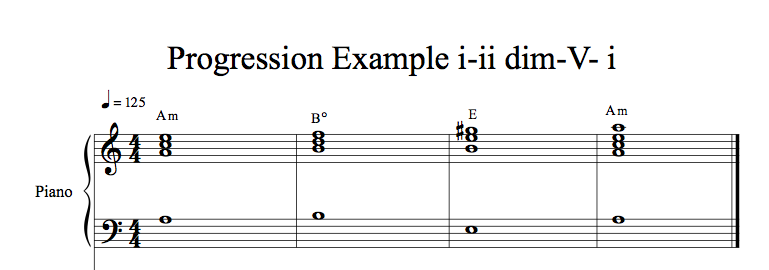
Here’s a cheat sheet for the common chord progression i–ii dim–V–i in each minor key, written in order. Pay attention to the unique sharp and flat pattern when playing through each key:
- A minor i iidim V i: Am–Bdim–E–Am
- B♭ minor i iidim V i: B♭m–Cdim–F–B♭m
- B minor i iidim V i: Bm–C♯dim–F♯–Bm
- C minor i iidim V i: Cm–Ddim–G–Cm
- C♯ minor i iidim V i: C♯m–D♯dim–G♯–C♯m
- D minor i iidim V i: Dm–Edim–A–Dm
- E♭ minor i iidim V i: E♭m–Fdim–B♭–E♭m
- E minor i iidim V i: Em–F♯dim–B–Em
- F minor i iidim V i: Fm–Gdim–C–Fm
- F♯ minor i iidim V i: F♯m–G♯dim–C♯–F♯m
- G minor i iidim V i: Gm–Adim–D–Gm
- A♭ minor i iidim V i: A♭m–B♭dim–E♭–A♭m
3. The i–VI–III–VII Chord Progression
This is another simple minor chord progression that will come up in numerous famous songs – you’ll see them in ballads pretty often.
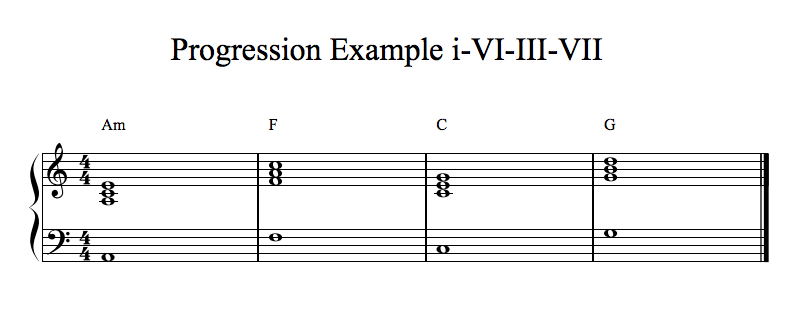
Here’s a little cheat sheet for the common chord progression i–VI–III–VII in each minor key, written in order. Pay attention to the unique sharp and flat pattern when playing through each key:
- A minor i VI III VII: Am–F–C–G
- B♭ minor i VI III VII: B♭m–G♭–D♭–A♭
- B minor i VI III VII: Bm–G–D–A
- C minor i VI III VII: Cm–A♭–E♭–B♭
- C♯ minor i VI III VII: C♯m–A–E–B
- D minor i VI III VII: Dm–B♭–F–C
- E♭ minor i VI III VII: E♭m–B–G♭–D♭
- E minor i VI III VII: Em–C–G–D
- F minor i VI III VII: Fm–D♭–A♭–E♭
- F♯ minor i VI III VII: F♯m–D–A–E
- G minor i VI III VII: Gm–E♭–B♭–F
- A♭ minor i VI III VII: A♭m–E–B–G♭
And Many More…
Beyond these basic progressions, there are many more that suit specific musical purposes. For example, we have the classic ii–V–i, a popular chord progression you’ll see a lot of in jazz, since it creates that “turnaround” sound.
There’s also the somewhat-misnamed Andalusian Cadence, a i–VII–VI–V progression that you’ll see come up in an astonishing array of musical styles, from Flamenco to metal to baroque.
The i–VII–VI progression is similar to the above, popularized by famous tunes such as Adele’s Rolling in the Deep and Jimi Hendrix’s All Along the Watchtower.
We could go on, but that’s enough theory for now. Let’s put your newfound knowledge to the test with some exercises in minor chord progressions.
Exercises in Minor
We’ll start you off nice and easy with some playalong exercises, then give you something a little more challenging and creative to try…
Exercise 1: i–iv–V–i Chord Progression
In this exercise you are going to practice playing along with chords following a simple minor chord progression: Am–Dm–E–Am, or the i iv V i progression.
- Listen to the example of the i iv V i progression.
- Look over the sheet music.
- Play the chord progression i iv V i along with the track on your instrument.
- Improvise over the chord progression.
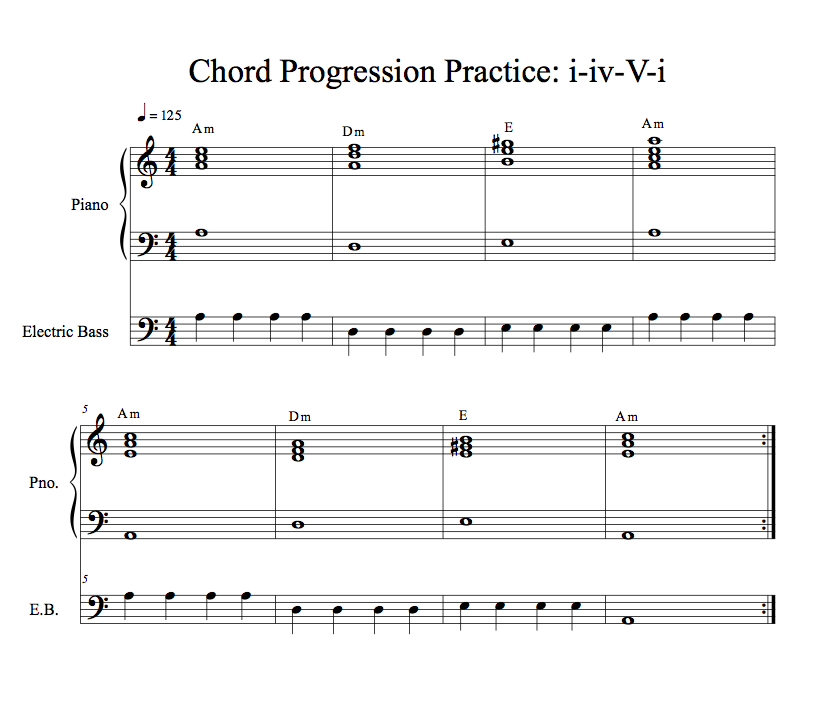
Remember that many chord progressions are built around these chords, using the i, iv, or V chord as a means to move the harmonic progression forward.
Exercise 2: i–ii dim–V–i Chord Progression
In this exercise you are going to practice playing along with chords following the simple chord progression: Am–B dim–E–Am.
- Listen to the example.
- Look over the sheet music.
- Play the chords along with the track on your instrument.
- Improvise over the chord progression.
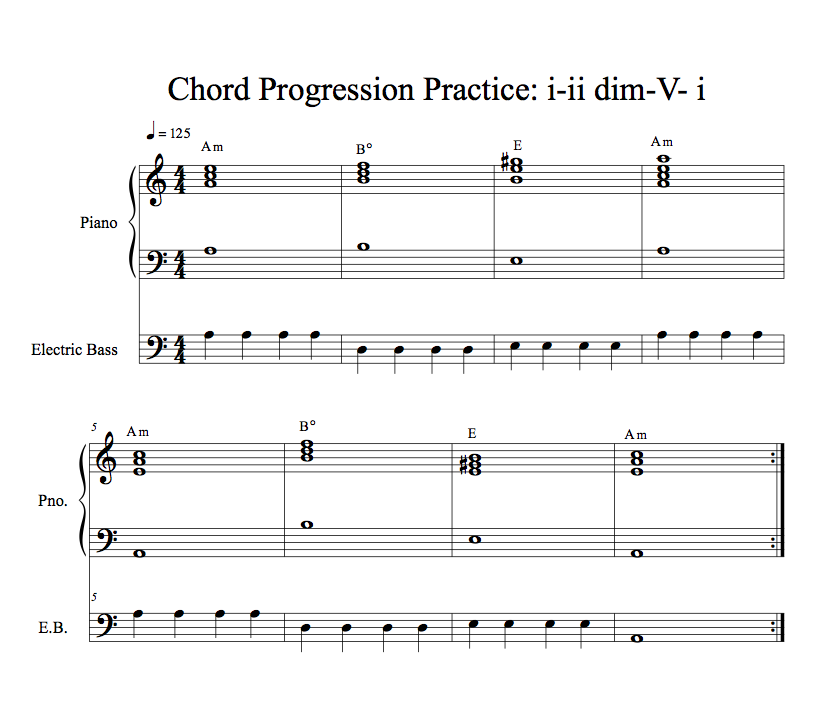
Exercise 3: Chord Progression Playalong
In this simple backing track to George Gershwin’s “Summertime” from Porgy and Bess, you can practice playing along with a longer minor chord progression in A Minor. While there are plenty of 7th chords in this track, you can easily drop the 7th and just play the basic triads like this instead:
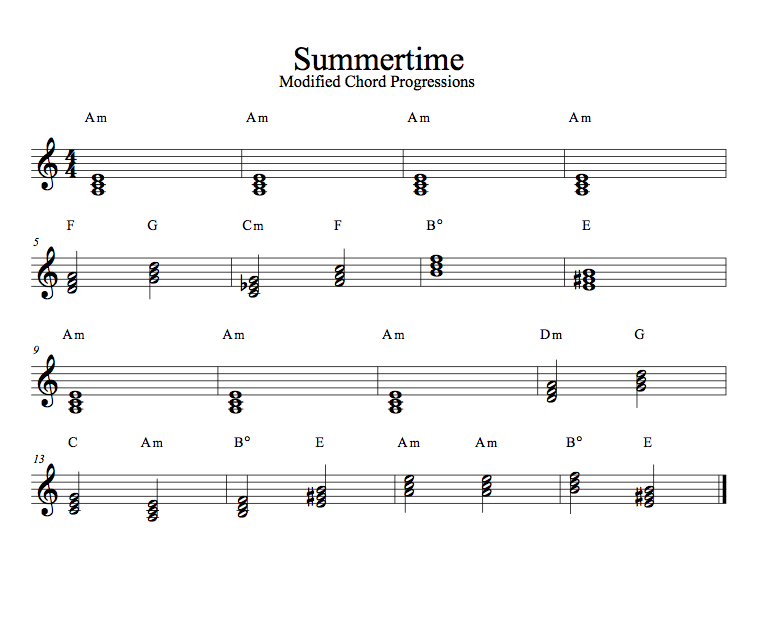
In this song you can hear how the chord progressions that come up tend to move towards the A minor chord and the E major chord. Remember than in most songs, the harmonic progression wants to resolve to the tonic (A) or the dominant (E), since those are the strongest resolutions.
- Review the modified chord progressions from “Summertime” above.
- Listen to the modified chords audio.
- Practice improvising and playing the chords in the modified version.
- Once you are comfortable with these chord progressions, then play the YouTube video below.
- Play the chords with the playalong track.
- Once you are comfortable with the modified chords, start to play the 7th chords in the YouTube video.
- Improvise over the playalong track.
If you find that playing along with the YouTube track is too difficult, then work with the modified chord audio. It always helps to use your ears to really hear for chord changes. Sometimes it can be difficult. Memorizing the sound and quality of the chords will help you as you learn these chords.
As you become more comfortable with playing the basic chord progression, you may find that some melodies for improvising over the progression pop into your head! Check out some tips for improvising over minor chord progressions on piano for some excellent ideas on where to start!
Notice that several minor key chord progressions can be extracted from this example.
- Measure 11: i–iv–VII–III–i
- Measure 13: i–ii dim–V–i
- Measure 15: i–ii dim–V
By starting with shorter chord progressions and learning how to combine them with other chord progressions, you will expand your harmonic skills.
Exercise 4: Build-Your-Own
In this article we talked about several different minor key chord progressions – there are of course many more, and most progressions can be turned from major to minor, even the 12-bar blues progression!
For this exercise, you will come up with your own minor chord progression. You will need a piece of paper and a pencil, and your instrument. Choose a key to use for this exercise (you might like to start with A minor).
If you can’t play chords on your instrument, try playing broken chords or arpeggios instead.
- Choose up to 4 chords from a minor key of your choice, and write a progression of 4 bars using these chords on a piece of paper. Start by using just the i, iv and v chords.
- Practice playing through your chord progression several times.
- Now choose another set of chords and write a new progression underneath your first one.
- Practice playing that new chord progression several times.
- Combine the two chord progressions into one long chord progression and play through all of the chords.
- Create a third chord progression from the same key and write it under the second one.
- Practice playing the third chord progression.
- Play through all three chord progressions without stopping.
- Continue adding chord progressions until you are playing through at least eight different chord progressions.
- Practice this same exercises with other keys.
Writing Your Own Minor Chord Progressions
When you’ve grown comfortable with the minor chord progressions we’ve introduced you to above, try writing your own! Don’t be afraid to use a minor chord progression chart or cheat sheet to quickly find the chords you’re looking for.
Building Minor Chord Progressions with the Circle of Fifths
The Circle of Fifths is just as useful for writing minor progressions as major ones. A refresher: adjacent minor keys on the circle are always a fifth apart, so for example, the relationship between A minor and E minor is the same as between C major and G major. Experiment with playing chord progressions that travel step by step and clockwise around the circle – you’ll find some instant classics!
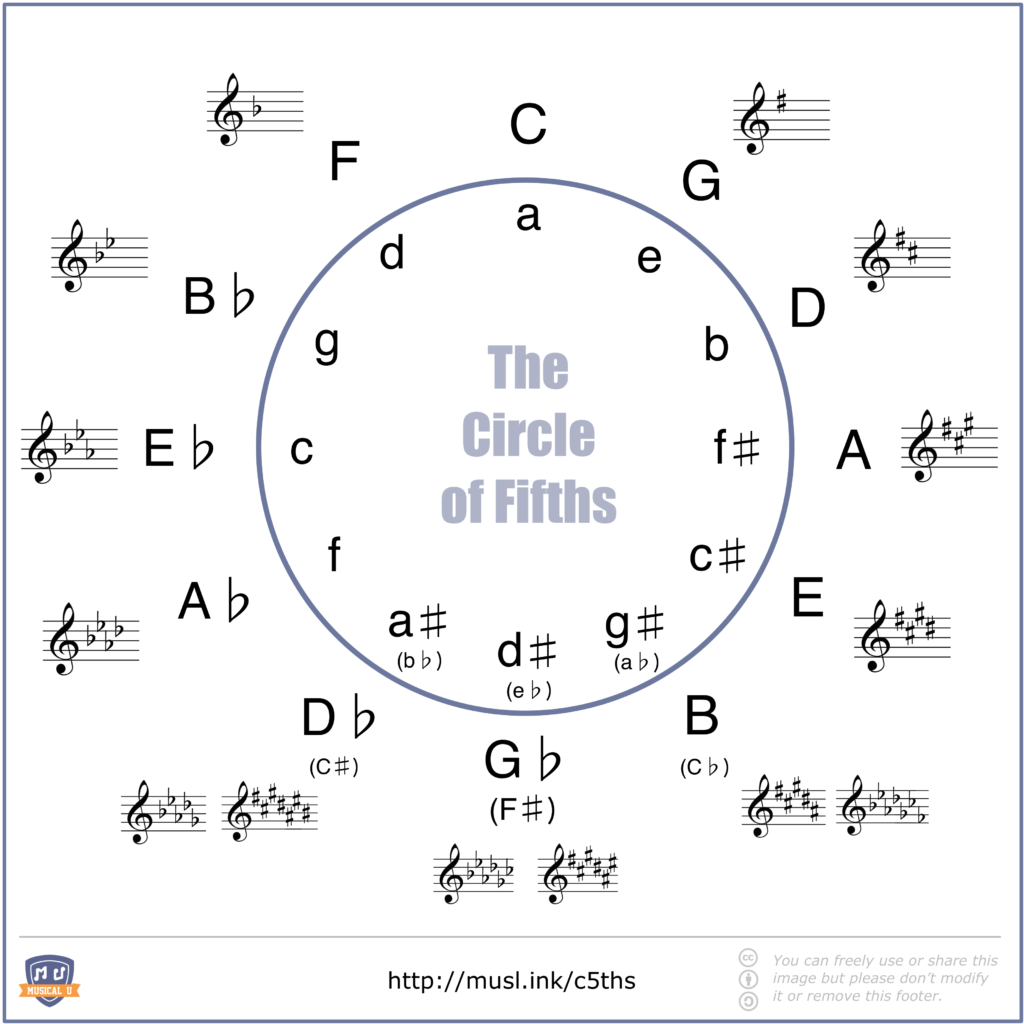
Match Chords to Moods to Lyrics
A sad song calls for sad minor chord progressions. But you can also throw some foreboding, tense, or even uplifting progressions in there to mix it up! Experiment with marrying specific progressions with certain moods in your song. Which ones fit best with certain parts of the song?
Use A Chord Progression Generator
If your fountain of creativity has run dry (and we doubt it ever will, considering the infinite possibilities of chord progressions!), try this Chord Progression Generator. Simply plug in the genre, feel (happy or sad?), and key that you want, and the generator will spit a readymade progression right back at you!
Your Minor Journey
There are many, many popular minor chord progressions. You have learned a few in this lesson and can use the practice tracks and music theory to continue to work on your musical skills. Continue to learn new progressions, combine progressions together to make longer songs, and keep an ear out for the infinite uses of minor chord progressions.
Experiment with chords and scales, combining both major and minor keys in your songs and training your ears for more kinds of minor chord progression. As you continue to expand your harmonic palette, you will be amazed at what you will create!

